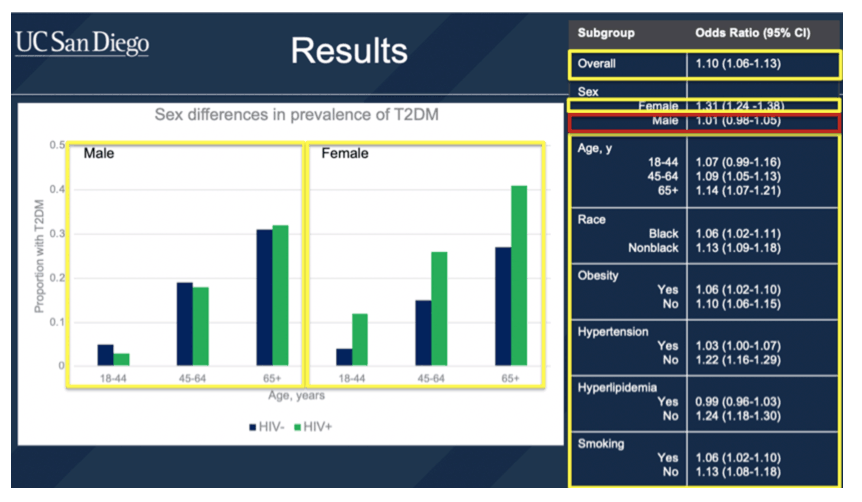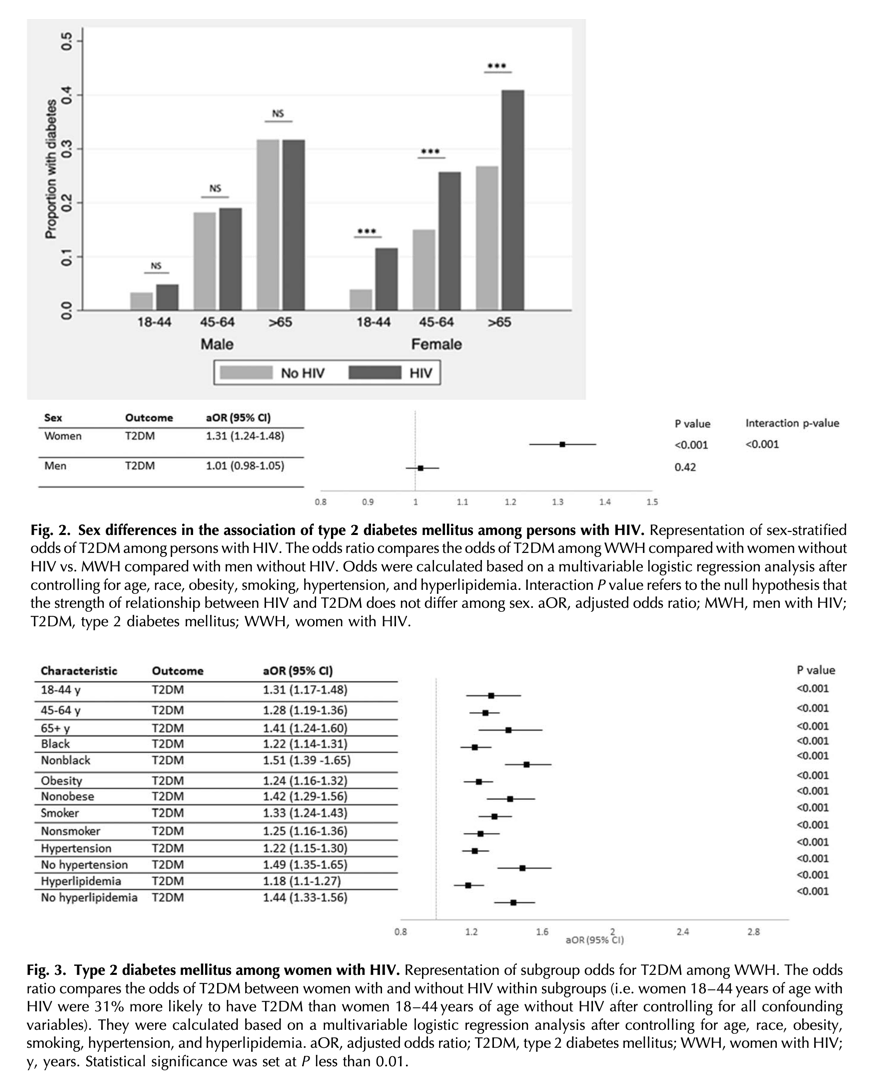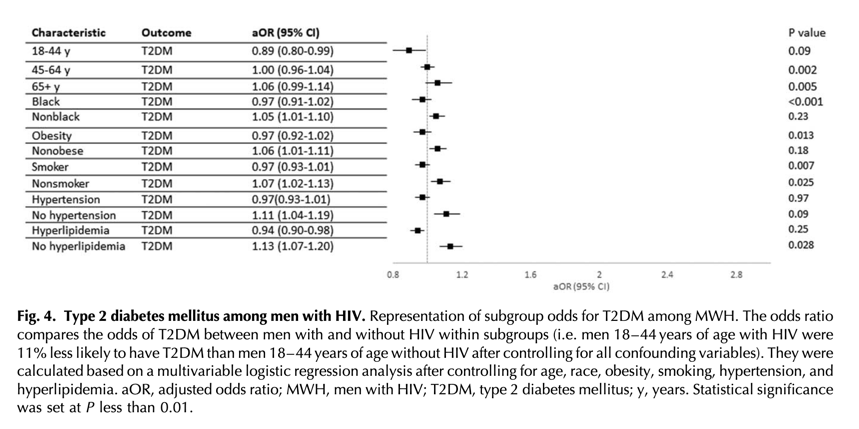| |
Sex differences in type 2 diabetes mellitus prevalence among
persons with HIV: women with HIV appear to have greater risk & >65 worse
|
| |
| |
Sex differences in type 2 diabetes mellitus prevalence
among persons with HIV
AIDS March 1 2022
In multivariable logistic regression analysis, there was a significant interaction between HIV and sex. WWH had 1.31 - 31% greater risk - (95% CI, 1.24-1.38) times the odds of having T2DM compared with women without HIV (Fig. 2). Moreover, T2DM was associated with WWH across all demographic and clinical subgroups (Fig. 3). The strength of relationship between WWH and T2DM was often stronger in the absence of a risk factor (i.e. nonobese WWH had stronger relationship with T2DM than obese WWH). In contrast, no association between HIV and T2DM was observed among men (aOR 1.01, 95% CI 0.98-1.05) (Fig. 1) including when stratified by subgroup variables of interest (Fig. 4).
These data suggest that HIV confers a sex-specific increase in odds of T2DM among women but not men.
---------------------------------
This was reported at CRO 2021 - here is NATAP original CROI report in this:
SEX DIFFERENCES IN DIABETES PREVELANCE AMONG PERSONS WITH HIV IN THE UNITED STATES...40% of HIV+ Women >65 have diabetes.

--------------------------------
Study Objective was to to examine whether type 2 diabetes mellitus (T2DM) is more common among women with HIV (WWH) than men with HIV (MWH).
Our results suggest that there is a sex-specific association between HIV and T2DM. T2DM prevalence was increased among all WWH [women] subgroups and remained increased after controlling for demographic and clinical risk factors. Our findings are consistent with the hypothesis that the greater inflammation observed among WWH combined with discordant prevalence of obesity may disproportionately increase the risk for T2DM among WWH.
as the population sample is drawn from various healthcare settings across all United States census regions, this study overcomes selection biases associated with tertiary single or multicenter investigations; thus, reinforcing the confidence that WWH carry a disproportionate burden of T2DM, suggesting that aggressive diagnosis, prevention, and management measures are needed.
Our data also provides further insight on the effect of HIV on the strength of the relationship between T2DM and subgroups of WWH. For example, nonobese WWH were 1.41 times more likely to have T2DM than nonobese WWH (Fig. 3). In contrast, obese WWH in comparison to obese women without HIV were 1.24 times more likely to have T2DM. These results suggest that HIV may more strongly increase the odds of T2DM in those whose risk of diabetes is not compounded by the presence of excess adiposity. However, among WWH with obesity, the effect is attenuated as obesity contributes to the strength of the relationship.
Although prevalence of obesity is markedly different between women and men with HIV, even after controlling for obesity, WWH remain more likely to have diabetes. This suggests other mechanisms are at play, which may include excessive chronic inflammation. Biologic factors should be considered as women have a stronger antiviral response than males attributed to sex-specific expression of toll-like receptor (TLR) genes and enhanced innate immune responses [6,31]. Although beneficial in acute infection, the heightened, persistent immune response against residual HIV likely contributes to maladaptive inflammation and higher risk for T2DM [5,32,33].

Among 10 125 WWH and 29 360 MWH, most were younger than 65 years of age (88 vs. 85%), whereas black race was more common among WWH (61 vs. 37%). Metabolic and cardiovascular risk factors disproportionately affected WWH compared with MWH including the proportion with obesity (58 vs. 35%) and hypertension (50 vs. 44%). Tobacco use was similar between WWH and MWH (53 vs. 55%).
Prevalence of type 2 diabetes mellitus
The prevalence of T2DM among WWH (23%) was higher compared with MWH (16%) and persons without HIV (15%). WWH were more likely to have T2DM than women without HIV across all age subgroups (Fig. 1). In contrast, MWH had a similar prevalence of T2DM as men without HIV (Fig. 1). In unadjusted analysis, HIV was associated with a diagnosis of T2DM among women (unadjusted OR 1.80, 95% CI, 1.71-1.88) but not among men (unadjusted OR 0.96, 95% CI, 0.93-0.99).
In multivariable logistic regression analysis, there was a significant interaction between HIV and sex. WWH had 1.31 (95% CI, 1.24-1.38) times the odds of having T2DM compared with women without HIV (Fig. 2). Moreover, T2DM was associated with WWH across all demographic and clinical subgroups (Fig. 3). The strength of relationship between WWH and T2DM was often stronger in the absence of a risk factor (i.e. nonobese WWH had stronger relationship with T2DM than obese WWH). In contrast, no association between HIV and T2DM was observed among men (aOR 1.01, 95% CI 0.98-1.05) (Fig. 1) including when stratified by subgroup variables of interest (Fig. 4).

Fig. 1. Sex differences in type 2 diabetes mellitus prevalence.
Proportion of persons with T2DM stratified by HIV serostatus, age,
and sex indicating increased prevalence among WWH compared with men without HIV. NS, nonsignificant; T2DM, type 2 diabetes
mellitus; WWH, women with HIV. Asterisks denotes P less than 0.001. Statistical significance was set at P less than 0.01

Abstract
Objective:
To examine whether type 2 diabetes mellitus (T2DM) is more common among women with HIV (WWH) than men with HIV (MWH).
Design:
A cross-sectional analysis of a demographically heterogenous population-based sample of more than 64 million patients in the United States.
Methods:
Using the Explorys (IBM) database, compare the prevalence of T2DM among men and women without HIV and influence of HIV on T2DM by sex controlling for confounding factors.
Results:
From 19 182 775 persons included in the study, 39 485 were with HIV. Rates of obesity was higher among WWH than MWH (58 vs. 35%). Prevalence of T2DM among WWH was 23% compared with 16% among MWH (P < 0.001). In sex-stratified adjusted analysis, WWH had 1.31 [95% confidence interval (CI), 1.24-1.38] times the odds of having T2DM than women without HIV. Women with HIV was associated with T2DM across all demographic subgroups. In contrast, no association between HIV and T2DM was observed among men (OR 1.01; 95% CI 0.98-1.05).
Conclusion:
These data suggest that HIV confers a sex-specific increase in odds of T2DM among women but not men.
|
|
| |
| |
|
|
|